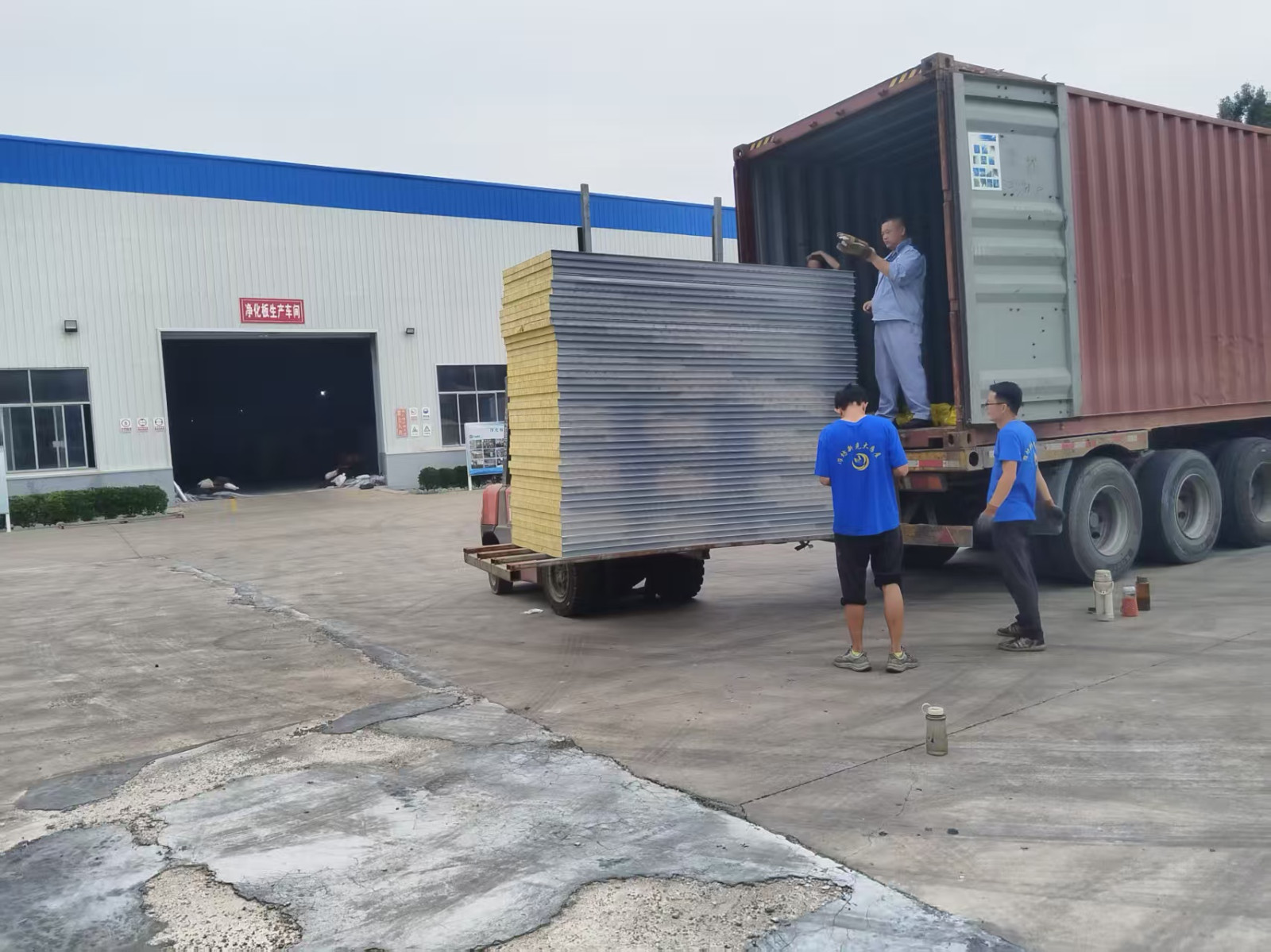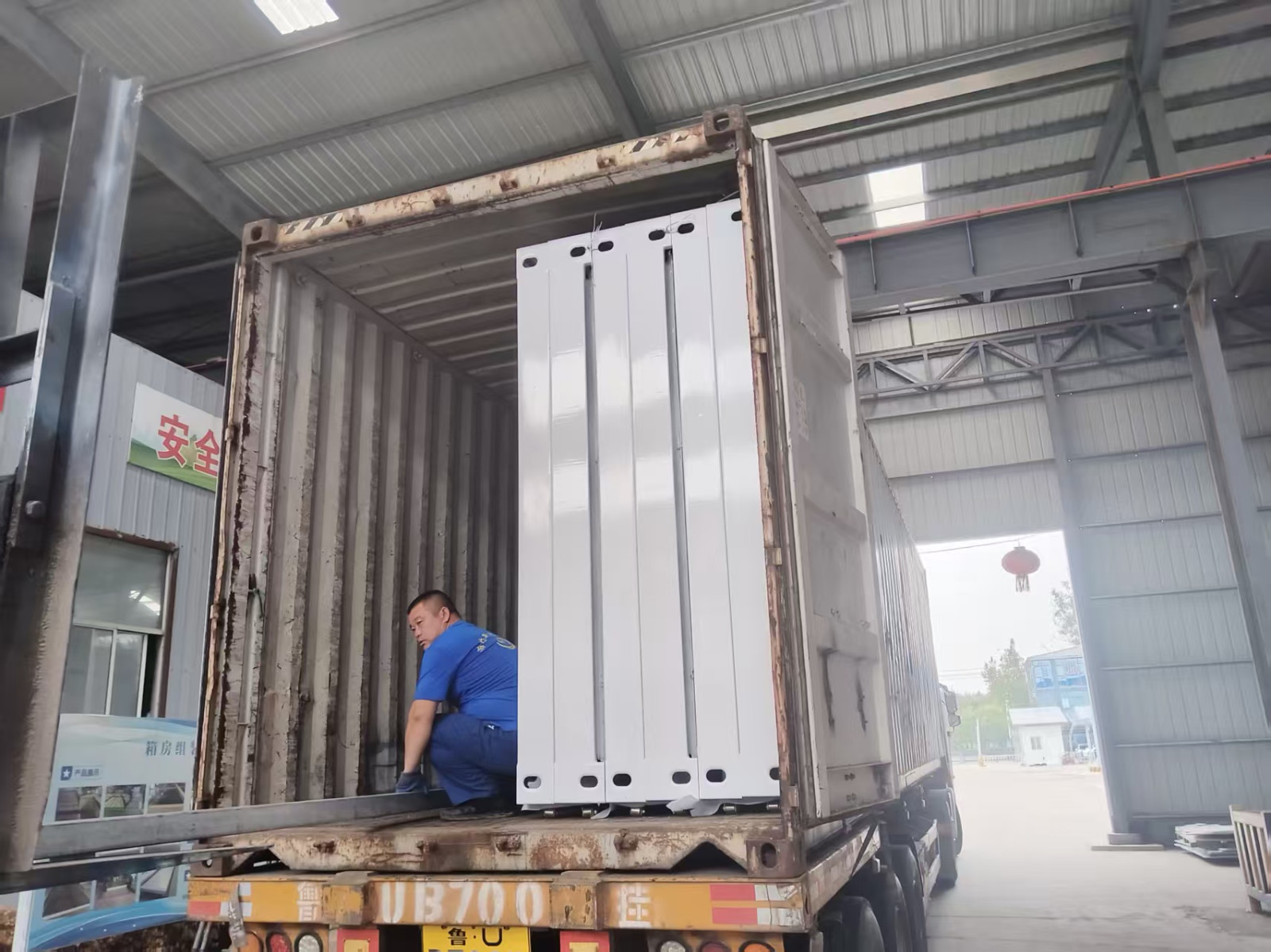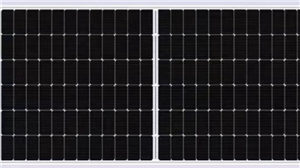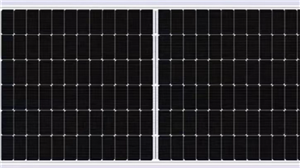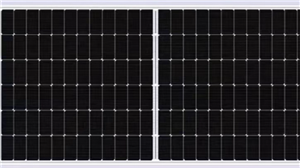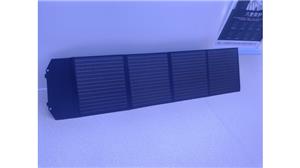Packing room, container loading and shipping
1、 The core preparation work before container loading is the key to avoiding shipment delays and reducing transportation losses, mainly covering three dimensions: "product inventory and protection", "container inspection", and "tool and personnel configuration":
1. Counting and protective treatment of packaging box room components. A packing box room is usually composed of standard modular units (such as ceiling, floor, columns, wall panels, door and window frames), connecting accessories (bolts, sealing strips, hardware), and auxiliary materials (wires, lighting fixtures, bathroom components, etc., if including interior). The quantity and specifications need to be checked one by one according to the shipping list to ensure that there are no missing or wrong parts. For vulnerable parts (such as glass, door and window profiles, interior panels), special protection is required: ◦ the glass surface is pasted with protective film, the edges are wrapped with foam corner guards, and separately packed into cardboard boxes or wooden boxes; Metal profiles (such as columns and beams) are covered with plastic caps at both ends to avoid scratching other components during transportation; Small accessories (bolts, screws) are classified according to specifications and placed in waterproof sealed bags, and then uniformly placed in turnover boxes to prevent loss.
2. Container inspection and pre-processing. The containers used for container loading are mostly 20 foot (approximately 6.058m long) or 40 foot (approximately 12.192m long) dry cargo boxes, which need to be inspected in advance to ensure compliance with transportation requirements: ◦ Structural inspection: The box body is not deformed, damaged, or leaking (can be judged by observing the internal transparency after closing the box door), and the floor is not sunken or loose (to avoid component pressure damage caused by insufficient load-bearing); Cleaning treatment: Remove debris and sharp protrusions (such as nails and welding slag) from the box, and if necessary, lay moisture-proof film or cardboard on the floor to prevent parts from getting damp or scratched; Identification confirmation: Check the container number and lead seal number to ensure consistency with the logistics documents and avoid misdelivery.
3. Tools and personnel preparation · Tools: equipped with forklifts (or hydraulic trailers, used to transport heavy modules), manual hoists (to adjust the position of parts), crowbars (to assist in alignment), tape measures (to measure space dimensions), packing belts/wrapping films (fixed parts), buffer materials (foam boards, bubble films, wood); Personnel: 2-4 people are required to collaborate (1 person to command, 1-2 people to operate machinery, and 1 person to assist in adjustment), and personnel need to be familiar with the weight of components (about 30-50kg for a single wall panel, about 300-500kg for a complete module) to avoid safety accidents caused by illegal operations.
2、 The core operation process of container loading (taking a 40 foot container as an example) should follow the principle of "heavy bottom, light top, large bottom, small top, and even distribution" to maximize the use of container space (with a volume of about 67.7m ³), while ensuring that there is no shaking or collision during transportation.
1. Bottom loading: Heavy core modules are prioritized for loading into "full container modules" with large weight and stable structure (such as pre installed chassis and side wall modules), using a "horizontal arrangement" or "vertical alignment" method: ◦ Horizontal arrangement: When the module width matches the container width (about 2.438m), it is placed in sequence along the length of the container, with a 5-10cm gap reserved between adjacent modules for easy disassembly during unloading; Vertical alignment: When the length of the module matches the length of the container, it should be placed tightly against the container wall, and the bottom should be padded with wooden blocks (5cm × 10cm in cross-section) to prevent the module from directly contacting the bottom of the container (to prevent moisture or friction damage). Key requirements: The total weight of the bottom components should not exceed the upper limit of the container's load-bearing capacity (usually around 26 tons per 40 foot container), and the center of gravity should be centered to avoid tilting of the container during transportation due to unbalanced loading.
2. Middle loading: middle layers of medium-sized parts and accessories are mainly used to place medium-sized parts such as wallboards, roof panels, door and window frames, etc. Attention should be paid to "layered isolation" and "scratch prevention": ◦ stacking of similar parts: neatly stack wallboards (or roof panels) of the same specification, with the height of each stack not exceeding 1.2m (about 6-8 pieces), and use foam plates to isolate between stacks to prevent wear of metal surface coating; Positioning of accessory box: Place the turnover box containing small accessories in the middle gap and secure it to adjacent modules with packing tape to avoid sliding or tipping during transportation.
3. Tools and personnel preparation · Tools: equipped with forklifts (or hydraulic trailers, used to transport heavy modules), manual hoists (to adjust the position of parts), crowbars (to assist in alignment), tape measures (to measure space dimensions), packing belts/wrapping films (fixed parts), buffer materials (foam boards, bubble films, wood); Personnel: 2-4 people are required to collaborate (1 person to command, 1-2 people to operate machinery, and 1 person to assist in adjustment), and personnel need to be familiar with the weight of components (about 30-50kg for a single wall panel, about 300-500kg for a complete module) to avoid safety accidents caused by illegal operations.
3、 Key links after shipment
Logistics tracking and document synchronization
After loading the container, logistics personnel need to record the container number, lead seal number, departure/loading time, and synchronize the logistics documents (bill of lading, packing list, customs declaration, if export is required) with the consignee; Real time tracking of transportation locations through logistics platforms such as freight apps and shipping company websites, and timely feedback on delays (such as traffic jams and port delays).
Receiver docking and unloading guidance
Before shipment, it is necessary to confirm the unloading location (with forklift or crane operating space) and unloading time with the consignee, and provide a "unloading sequence guide":
Unloading sequence: Follow the reverse operation of "top layer → middle layer → bottom layer", unload light components first, then medium-sized components, and finally unload heavy modules at the bottom layer to avoid damage to the lower layer caused by pressure from upper components;
Attention: Remind the recipient to inspect the appearance of the components (such as whether the coating is damaged or the glass is broken). If there is any damage, take photos on the spot and communicate with the shipper for after-sales service in a timely manner.
1. Counting and protective treatment of packaging box room components. A packing box room is usually composed of standard modular units (such as ceiling, floor, columns, wall panels, door and window frames), connecting accessories (bolts, sealing strips, hardware), and auxiliary materials (wires, lighting fixtures, bathroom components, etc., if including interior). The quantity and specifications need to be checked one by one according to the shipping list to ensure that there are no missing or wrong parts. For vulnerable parts (such as glass, door and window profiles, interior panels), special protection is required: ◦ the glass surface is pasted with protective film, the edges are wrapped with foam corner guards, and separately packed into cardboard boxes or wooden boxes; Metal profiles (such as columns and beams) are covered with plastic caps at both ends to avoid scratching other components during transportation; Small accessories (bolts, screws) are classified according to specifications and placed in waterproof sealed bags, and then uniformly placed in turnover boxes to prevent loss.
2. Container inspection and pre-processing. The containers used for container loading are mostly 20 foot (approximately 6.058m long) or 40 foot (approximately 12.192m long) dry cargo boxes, which need to be inspected in advance to ensure compliance with transportation requirements: ◦ Structural inspection: The box body is not deformed, damaged, or leaking (can be judged by observing the internal transparency after closing the box door), and the floor is not sunken or loose (to avoid component pressure damage caused by insufficient load-bearing); Cleaning treatment: Remove debris and sharp protrusions (such as nails and welding slag) from the box, and if necessary, lay moisture-proof film or cardboard on the floor to prevent parts from getting damp or scratched; Identification confirmation: Check the container number and lead seal number to ensure consistency with the logistics documents and avoid misdelivery.
3. Tools and personnel preparation · Tools: equipped with forklifts (or hydraulic trailers, used to transport heavy modules), manual hoists (to adjust the position of parts), crowbars (to assist in alignment), tape measures (to measure space dimensions), packing belts/wrapping films (fixed parts), buffer materials (foam boards, bubble films, wood); Personnel: 2-4 people are required to collaborate (1 person to command, 1-2 people to operate machinery, and 1 person to assist in adjustment), and personnel need to be familiar with the weight of components (about 30-50kg for a single wall panel, about 300-500kg for a complete module) to avoid safety accidents caused by illegal operations.
2、 The core operation process of container loading (taking a 40 foot container as an example) should follow the principle of "heavy bottom, light top, large bottom, small top, and even distribution" to maximize the use of container space (with a volume of about 67.7m ³), while ensuring that there is no shaking or collision during transportation.
1. Bottom loading: Heavy core modules are prioritized for loading into "full container modules" with large weight and stable structure (such as pre installed chassis and side wall modules), using a "horizontal arrangement" or "vertical alignment" method: ◦ Horizontal arrangement: When the module width matches the container width (about 2.438m), it is placed in sequence along the length of the container, with a 5-10cm gap reserved between adjacent modules for easy disassembly during unloading; Vertical alignment: When the length of the module matches the length of the container, it should be placed tightly against the container wall, and the bottom should be padded with wooden blocks (5cm × 10cm in cross-section) to prevent the module from directly contacting the bottom of the container (to prevent moisture or friction damage). Key requirements: The total weight of the bottom components should not exceed the upper limit of the container's load-bearing capacity (usually around 26 tons per 40 foot container), and the center of gravity should be centered to avoid tilting of the container during transportation due to unbalanced loading.
2. Middle loading: middle layers of medium-sized parts and accessories are mainly used to place medium-sized parts such as wallboards, roof panels, door and window frames, etc. Attention should be paid to "layered isolation" and "scratch prevention": ◦ stacking of similar parts: neatly stack wallboards (or roof panels) of the same specification, with the height of each stack not exceeding 1.2m (about 6-8 pieces), and use foam plates to isolate between stacks to prevent wear of metal surface coating; Positioning of accessory box: Place the turnover box containing small accessories in the middle gap and secure it to adjacent modules with packing tape to avoid sliding or tipping during transportation.
3. Tools and personnel preparation · Tools: equipped with forklifts (or hydraulic trailers, used to transport heavy modules), manual hoists (to adjust the position of parts), crowbars (to assist in alignment), tape measures (to measure space dimensions), packing belts/wrapping films (fixed parts), buffer materials (foam boards, bubble films, wood); Personnel: 2-4 people are required to collaborate (1 person to command, 1-2 people to operate machinery, and 1 person to assist in adjustment), and personnel need to be familiar with the weight of components (about 30-50kg for a single wall panel, about 300-500kg for a complete module) to avoid safety accidents caused by illegal operations.
3、 Key links after shipment
Logistics tracking and document synchronization
After loading the container, logistics personnel need to record the container number, lead seal number, departure/loading time, and synchronize the logistics documents (bill of lading, packing list, customs declaration, if export is required) with the consignee; Real time tracking of transportation locations through logistics platforms such as freight apps and shipping company websites, and timely feedback on delays (such as traffic jams and port delays).
Receiver docking and unloading guidance
Before shipment, it is necessary to confirm the unloading location (with forklift or crane operating space) and unloading time with the consignee, and provide a "unloading sequence guide":
Unloading sequence: Follow the reverse operation of "top layer → middle layer → bottom layer", unload light components first, then medium-sized components, and finally unload heavy modules at the bottom layer to avoid damage to the lower layer caused by pressure from upper components;
Attention: Remind the recipient to inspect the appearance of the components (such as whether the coating is damaged or the glass is broken). If there is any damage, take photos on the spot and communicate with the shipper for after-sales service in a timely manner.
Through the standardized container loading and shipping process mentioned above, efficient and safe delivery from the production plant to the project site can be achieved, while reducing transportation losses (the industry loss rate can be controlled within 1%), laying the foundation for rapid assembly in the future.
